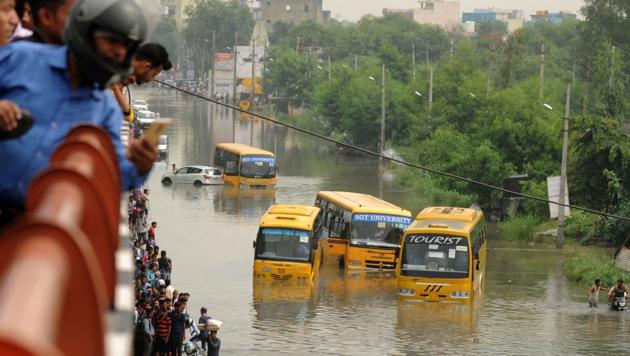Gurugram struggling to fix drainage
Officials say haphazard planning, concrete drains, unchecked realty boom cause repeated waterlogging.
Severe waterlogging across Gurugram, as it took place on Tuesday morning that left the city crippled, may be rare in its extremity.

The problem, however, is a perennial one, albeit at a smaller magnitude, with many areas getting inundated following each spell of rain.
Officials who have been involved in managing the city said that the problem started intensifying due to unplanned expansion and execution of ideas without a comprehensive study.
“Until the Badshahpur drain was constructed, Gurugram’s drainage system was primarily dependent upon a network of natural drains. Water run-off from the Aravallis used to flow towards the low-lying areas of the city and strategically placed check dams would route the water towards the Najafgarh drain. As a result, the city was free of waterlogging,” said Rajeev Sharma, the first commissioner of the Municipal Corporation of Gurugram (MCG) when it was constituted in 2008.
“As the city’s real estate boomed in the late 1990s and the early 2000s, the check dams and natural drains started diminishing and concrete structures prevented water from seeping in,” said Sharma.
It was in 2008 when the MCG was formed and took over from the then cash-strapped real estate body, Haryana Urban Development Authority (Huda), that the idea of a ‘main drain’ for Gurugram emerged, to channel the city’s drain water towards the Najafgarh drain in New Delhi. The Badshahpur drain finally came into place a year later, in 2009.
The idea that was supposed to resolve waterlogging issues, however, was soon found to come with its own set of issues. The concretisation of the drain, it was discovered, did not allow water to seep into the soil naturally, creating a problem at various sections, including at Khandsa village, where the drain becomes narrower, causing water to overflow each time it rains.
Similar concretised drains had also been constructed in other parts of the city, replacing the natural drains in several places.
This type of short-term, haphazard planning, experts say, is part of the problem, along with negligence on the part of authorities when it comes to crucial practices, such as desilting.
“Gurugram is still a relatively new city, but it is a victim of haphazard planning. Large swathes of land were developed by private builders, regardless of whether the civic amenities, such as a drainage system, were put in place,” said Mukta Naik, an urban planner and a senior researcher at the Centre for Policy Research.
“Hence, currently, roads are not designed alongside drains. Often, drains are not properly connected to one another and where they exist, they are also not properly desilted, which makes the city susceptible to waterlogging,” she said.
Another idea of the civic body, approved in 2015, that has similarly failed is that of introducing ‘box drains’, which essentially involves placing a filter that blocks impurities from flowing into drains, preventing them from getting clogged.
Similar to the Badshahpur drain, waterlogging at these drains had also garnered the spotlight, due to their ineffectiveness, in the aftermath of the 2016 deluge, with TL Satyaprakash, then MCG commissioner, conceding that, although the idea was ‘sound’ on paper, it was ineffective due to a lack of regular cleaning of the box drains and removal of impurities, which was crucial for them to work. In the absence of cleaning, water did not flow through the drain at all, he said.
Two years after the 2016 deluge, MCG officials are still trying to undo this error, as certain box drains continue to be plagued with this problem.
MCG officials said that this is not a problem specific to box drains, revealing that maintenance of drains needs more attention.
According to MCG officials, until June 1 this year, only 40% of the drains across the city had been cleaned, a fact that could have contributed to the waterlogging on Tuesday.
Another plan that was conceptualised by officials after the 2016 incident, a traffic improvement programme, has emerged as a double-edged sword.
The plan involved the construction of several new underpasses and flyovers to allow a seamless flow of vehicles along the highway.
Due to a dearth of proper planning, however, these have only served to aggravate the problem, with two underpasses – a bidirectional one at Signature Tower and a unidirectional one at Rajiv Chowk – being constructed in such a way that they have blocked the underground drain channels, turning these structures and the area around them vulnerable to waterlogging.
While the drainage line that was obstructed at the Rajiv Chowk underpass has recently been pinpointed and work commenced to resolve the problem, the network at Signature Towers continues to elude officials, as a result of which roads continue to remain waterlogged.
The issue is not limited to arterial roads alone. Even internal roads in areas such as sectors 28 and 29, waterlogging is a major problem, due to land litigation issue.
A 1,750-square yard plot at Regency Park 1 in Sector 43 is under litigation, due to which an eight-kilometre-long stormwater drain has not been completed and there is no gateway to discharge rainwater, causing waterlogging in these two areas.
A six-kilometre portion of the drain, from Sector 56 to Sector 43, has been completed, but work on the remaining two-kilometre portion, from Regency Park 1 to Chakkarpur village has stalled. On Tuesday, there was three feet of rainwater in the area.

Stay updated with all the Breaking News and Latest News from Mumbai. Click here for comprehensive coverage of top Cities including Bengaluru, Delhi, Hyderabad, and more across India along with Stay informed on the latest happenings in World News.
Stay updated with all the Breaking News and Latest News from Mumbai. Click here for comprehensive coverage of top Cities including Bengaluru, Delhi, Hyderabad, and more across India along with Stay informed on the latest happenings in World News.





